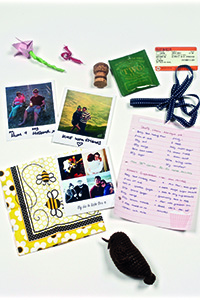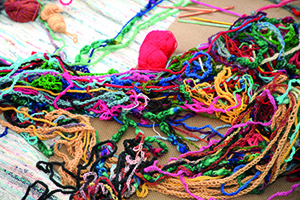Parallel Practices
Textile artist and ceramicist Angela Maddock was appointed maker-in-residence in the Florence Nightingale Faculty of Nursing, Midwifery and Palliative Care. She was asked to explore and develop ‘material empathy’ with nursing and midwifery students through their engagement in craft practice.
Early discussions between Angela and faculty lecturers revealed many natural affinities between their two areas of practice: the role of touch and craft in nursing and the caring aspects of making. As the residency progressed, further parallels were revealed, such as stitching and suturing, clothing and intimacy, touch and empathy, and repair and resilience. All rich and valuable areas to explore as a means of supporting students to develop key competencies and attributes for good clinical practice: haptic skills, empathy, reflection, resilience and self-care.
Over the course of the residency, a number of distinctive projects emerged. Patching Up invited students to choose a valued object in need of repair and, through a process of discussion, reflection and negotiation, develop a care plan for the object.
The Intimate Quilt brought together staff and students to create a quilt from their own underwear at a quilting bee, a social event in which people gather to stitch together a quilt. The programme enabled participants to explore themes of intimacy that are central to their midwifery practice. Discussions were framed within the cultural history of quilt-making and the Angela shared journal articles on topics such as shame and repair.
 The Little Tin of Resilience provided staff and students with a small tin decorated with a nightingale, together with instructions on how to fill it with meaningful objects meaningful to create their own personal resilience toolkit. Angela conducted one-to-one interviews on the tin’s contents, transcribed excerpts from the interviews and these, along with studio portraits of the tins and their laid-out content, were exhibited with the quilt at an exhibition of the students work at King’s.
The Little Tin of Resilience provided staff and students with a small tin decorated with a nightingale, together with instructions on how to fill it with meaningful objects meaningful to create their own personal resilience toolkit. Angela conducted one-to-one interviews on the tin’s contents, transcribed excerpts from the interviews and these, along with studio portraits of the tins and their laid-out content, were exhibited with the quilt at an exhibition of the students work at King’s.
Reflecting on the experience one student, ‘I really needed today. After an emotionally intense study day, which has left me feeling wrung out like an old washcloth, to sit and unpick has helped me re-centre and process some of my emotion.’ Another added, ‘I admire the ease and lightness with which Angela creates the first stitches then [as I] create my less delicate replication, I am reminded of all the skill being passed onto me by other midwives and how some things just take practice.’
 Angela Maddock’s residency formed part of wider collaborative initiative with the Crafts Council that sought to explore how the presence of craft makers might enrich research and teaching across health and science faculties.
Angela Maddock’s residency formed part of wider collaborative initiative with the Crafts Council that sought to explore how the presence of craft makers might enrich research and teaching across health and science faculties.
“The process of handing over the mug to the project was rather like admitting a patient into hospital ... It was a wonderful opportunity to reflect on the healing process our patients go through. How it must feel for their families as they hand their loved ones into our care.” Student participant
Conclusions
| The ‘sideways’ methodology of discussing difficult issues and experiences through objects and craft-making provided a safe but powerful space for individual and shared reflection. |
| The usual hierarchies between staff and students were gradually diminished, leading to frank and open conversations about both their personal and professional lives. |
| Many students spoke of how the making sessions provided a haven after a stressful day, and many were surprised by the depth of emotions that they began to share. |
| Students written reflections demonstrated that the activities helped them to relate their own feelings – of anxiety and loss for example – to the feelings that patients and families might be experiencing. They could also see how making activities might be used as a means for communicating with patients with whom they didn’t share a language. |
| The metaphors between making and midwifery also helped the participants to appreciate the artistry of their own practice, allowing them to take satisfaction in their existing skills and to see that they would become better at the new clinical skills they were learning, through time and practice. Sue Woodward, Carole Fordham-Clarke, Tanya Graeme, Anne-Marie Rafferty, Ian Noonan, Penny Charles and Elsa Montgomery in collaboration with artist and ceramicist Angela Maddock. |
Student feedback
The process of handing over the mug to the project was rather like admitting a patient into hospital ... It was a wonderful opportunity to reflect on the healing process our patients go through. How it must feel for their families as they hand their loved ones into our care.
I admire the ease and lightness with which Angela creates the first stitches then [as I] create my less delicate replication, I am reminded of all the skill being passed ontome by other midwives and how some things just take practice.
I really needed today. After an emotionally intense study day, which has left me feeling wrung out like an old washcloth, to sit and unpick has helped me re-centre and process some of my emotion.
I like how sewing the quilt directly relates to suturing in practice.
Project team
Sue Woodward, Carole Fordham-Clarke, Tanya Graeme, Anne-Marie Rafferty, Ian Noonan, Penny Charles and Elsa Montgomery in collaboration with artist and ceramicist Angela Maddock.